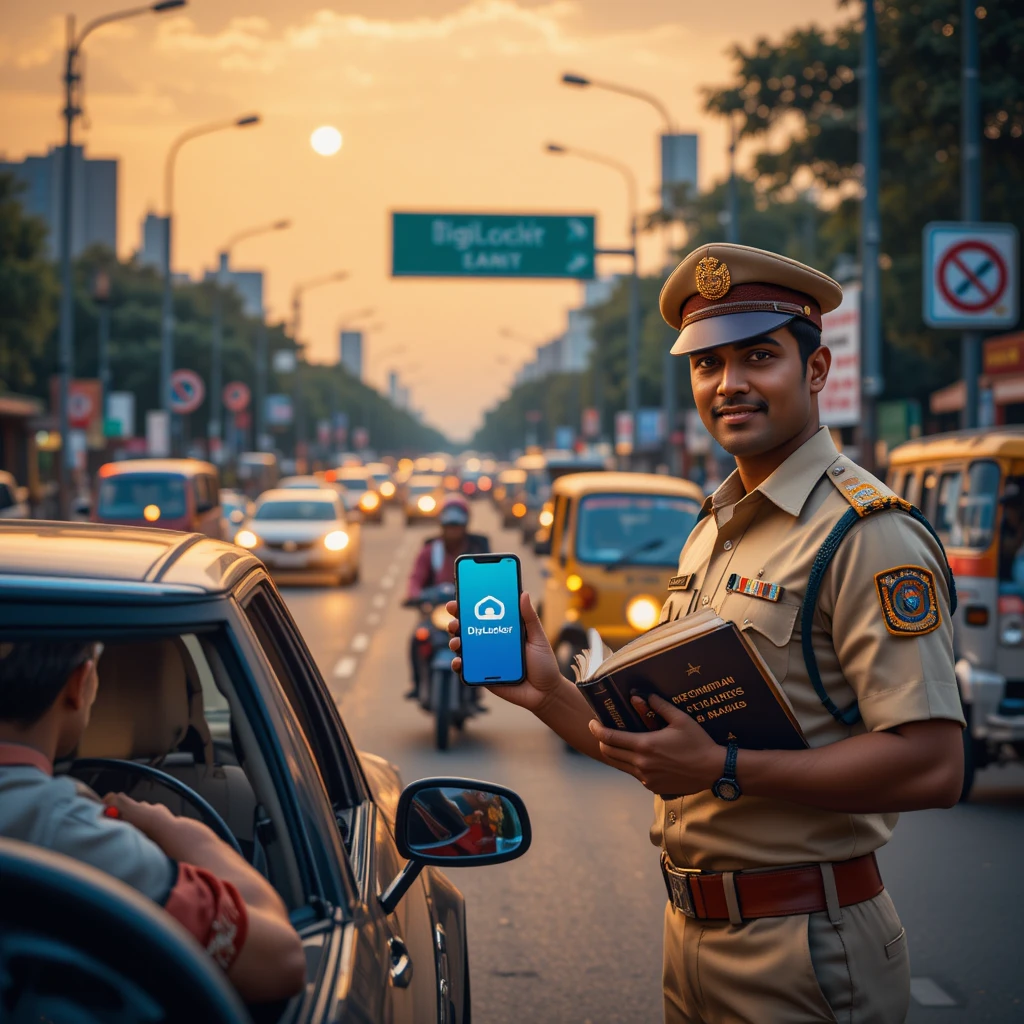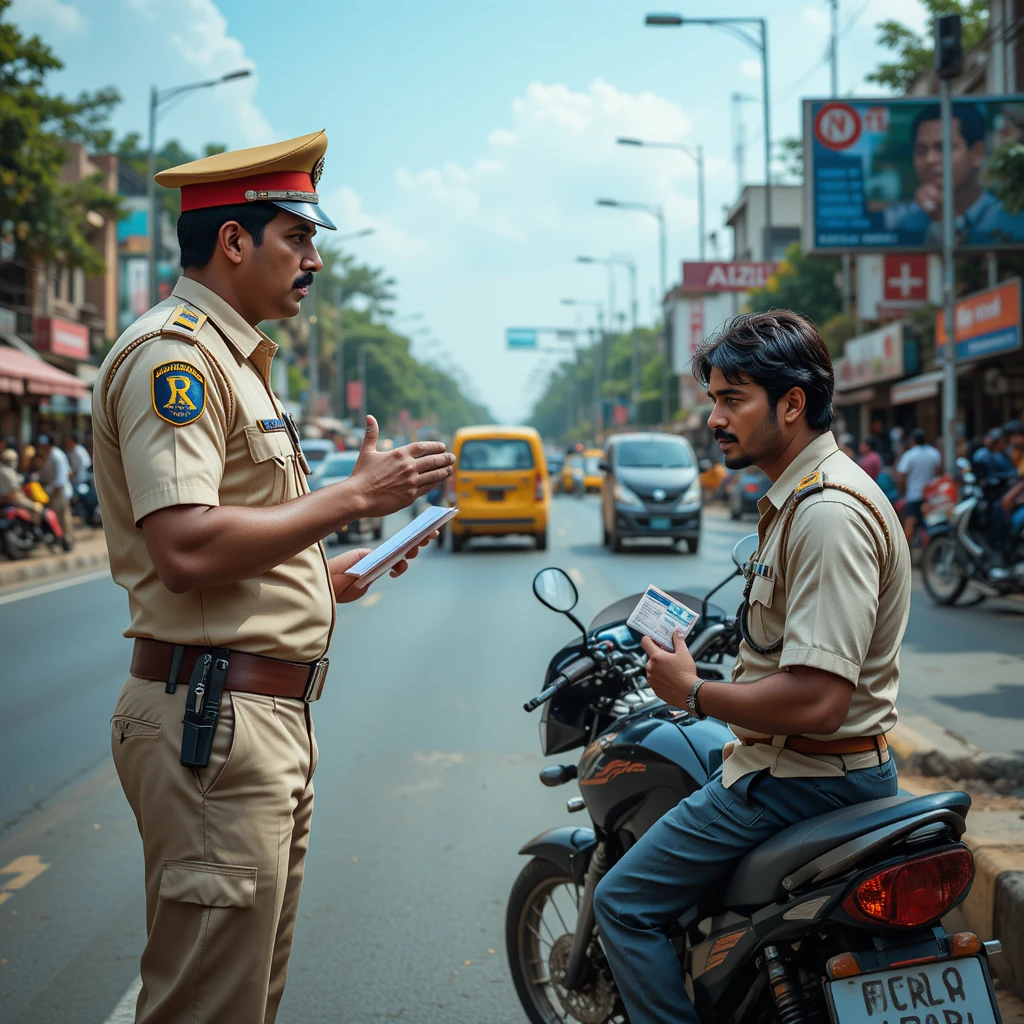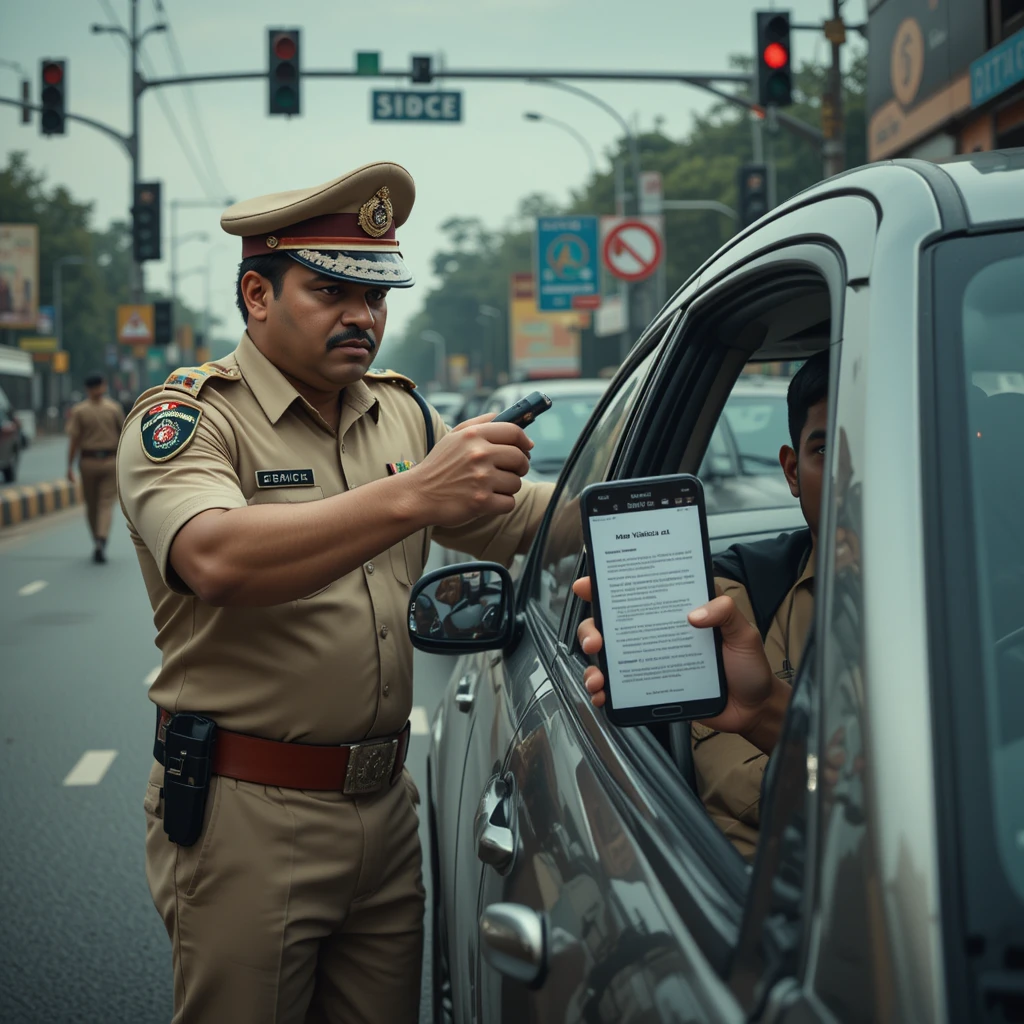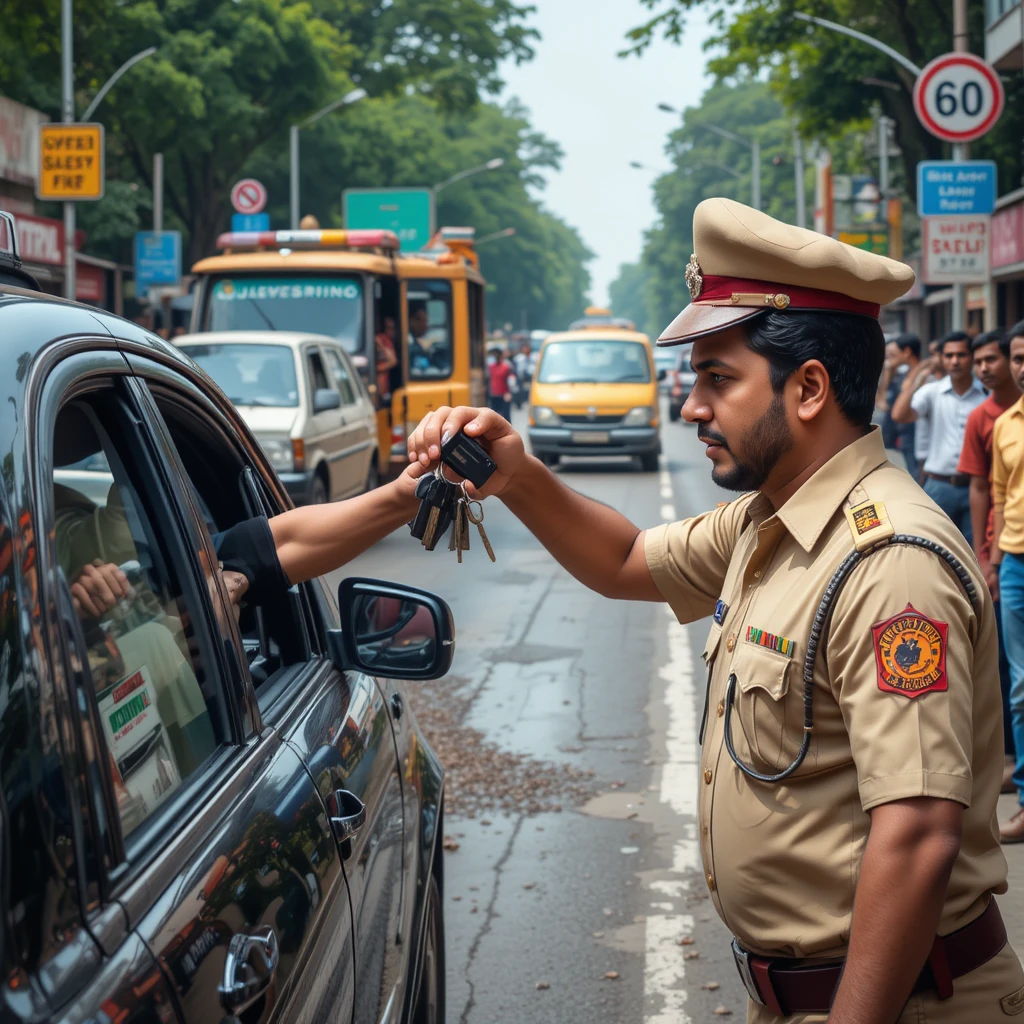In India, traffic police play a vital role in maintaining road safety and enforcing the Motor Vehicles Act (MVA), 1988, and its amendments. However, interactions with traffic police can sometimes lead to harassment, exploitation, or misapplication of the law, particularly for drivers unaware of their legal rights. This article explores the common issues drivers face with traffic police, how the MVA is misused to exploit drivers, probable incidents of misconduct, the authority to demand or seize documents, the legality of actions like key snatching, and specific provisions of the MVA and Central Motor Vehicles Rules (CMVR), 1989, that empower drivers to protect themselves. By understanding these legal protections, drivers can confidently navigate encounters with traffic police and assert their rights.

Table of Contents
Common Issues Faced by Drivers with Traffic Police
Drivers in India often encounter the following issues during interactions with traffic police, which can range from procedural oversights to outright exploitation:

- Harassment and Intimidation
Some traffic police officers use their authority to intimidate drivers, particularly those unfamiliar with traffic laws, such as young drivers, students, or out-of-state vehicle owners. Intimidation tactics include threats of vehicle impoundment, license suspension, or hefty fines for minor or fabricated violations. For example, a driver may be threatened with a court case for a minor infraction like crossing a stop line, pushing them to pay a bribe to avoid further hassle. - Demanding Bribes
Instead of issuing official challans (fines), some officers demand cash payments to “settle” violations on the spot. This exploits drivers’ fear of legal proceedings or the inconvenience of visiting a court. For instance, a motorist stopped for not wearing a helmet may be asked to pay ₹500 in cash instead of the official ₹100 fine under Section 194D of the MVA. - Misapplication of the Motor Vehicles Act
Officers may misquote or twist MVA provisions to impose higher fines or penalties than legally permitted. This is common when drivers are unaware of the actual fine amounts or rules. For example, a driver may be fined ₹5,000 for driving without a license under Section 181, even if they have a valid digital license on DigiLocker. - Unauthorized Actions
Lower-ranking officers, such as constables, may demand documents or attempt to seize vehicle keys, actions reserved for officers of Assistant Sub-Inspector (ASI) rank or above. For instance, a constable demanding a registration certificate without authority violates Section 130’s procedural requirements. - Targeting Vulnerable Groups
Out-of-state drivers, minors, or those with older vehicles are often targeted, as they are less likely to challenge authority. An out-of-state vehicle may be stopped under the pretext of document verification, even though no rule permits penalizing vehicles solely for their registration status. - Improper Document Seizure
Officers may seize documents like driving licenses or registration certificates without issuing a receipt, which is illegal under Section 206. For example, a driver’s license may be confiscated for a minor offense like improper parking without providing a receipt, leaving the driver vulnerable to further harassment. - Excessive or Incorrect Fines
Fines may exceed legal limits or be issued for non-offenses, exploiting drivers’ lack of knowledge. A head constable imposing a ₹1,000 fine, beyond their ₹100 limit, or fining repeatedly for the same offense in a day (prohibited except for overspeeding) is a common issue. - Refusal to Accept Digital Documents
Despite amendments recognizing digital documents via DigiLocker or mParivahan, some officers insist on physical copies to justify fines. For example, a driver presenting a digital PUC certificate may be fined under Section 190(2), even though digital copies are valid under Rule 139, CMVR.
Exploitation Through Misapplication of the Motor Vehicles Act
Traffic police may exploit drivers by twisting or misrepresenting MVA provisions in the following ways:
- Misrepresenting Authority: Constables or head constables may act as if they can issue fines or seize documents, powers reserved for ASI or higher-ranking officers under Section 130. For example, a constable demanding a driving license lacks the legal authority to do so.
- Citing Non-Existent Rules: Officers may claim that documents like PUC certificates must be carried physically, ignoring Rule 139, CMVR, which validates digital copies.
- Pressuring for Bribes: By threatening severe penalties, such as vehicle impoundment under Section 207, officers coerce drivers into paying bribes instead of official fines.
- Ignoring Digital Documentation: Rejecting valid digital documents, despite MoRTH notifications (e.g., September 19, 2018) recognizing DigiLocker and mParivahan, to create a pretext for fines.
- Exaggerating Violations: Minor infractions, like parking in a no-parking zone, may be portrayed as serious offenses under Section 184 (dangerous driving) to justify higher fines or document seizure.

Probable Incidents of Misconduct
Based on the MVA and reported experiences, here are probable incidents where traffic police may overstep their authority or exploit drivers:
- Stopping Vehicles Without Cause: Random checks without reasonable suspicion, often to harass or extract bribes.
- Snatching Vehicle Keys: Removing keys from the ignition, which is explicitly prohibited under the MVA.
- Unauthorized Document Seizure: Seizing documents without issuing a receipt or legal justification.
- Demanding Physical Documents: Insisting on physical copies despite digital documents being valid under Rule 139, CMVR.
- Imposing Excessive Fines: Charging fines beyond an officer’s authority or for non-offenses.
- Threatening Impoundment: Threatening to tow a vehicle with someone inside, which violates Section 207’s conditions.
- Harassment of Vulnerable Drivers: Targeting out-of-state or young drivers for fines or bribes.
- Forcing Drivers Out of Vehicles: Demanding drivers exit their vehicle without legal grounds (e.g., no suspicion of drunk driving under Section 185).
- Ignoring Good Samaritan Protections: Harassing witnesses of accidents, despite protections under Section 134A.
- Fabricating Offenses: Accusing drivers of violations like overspeeding (Section 183) without evidence, such as speed gun readings.

Who Can Demand or Seize Documents?
- Authorized Personnel:
- Only officers of Assistant Sub-Inspector (ASI), Sub-Inspector (SI), or Inspector rank are authorized to demand and seize documents under Section 130 of the MVA.
- Constables cannot issue fines or demand documents but can assist higher-ranking officers.
- Head Constables can issue fines up to ₹100, as per state traffic police guidelines.
- Only Regional Transport Office (RTO) officials can demand PUC certificates, not traffic police, as per Section 115 and CMVR.
- Officers must be in uniform with a visible name tag or provide identification if in civilian attire, as per police protocols.
- Documents to Be Presented:
- Driving License: Must be shown on demand (Section 130, MVA).
- Registration Certificate, Insurance, PUC: Can be shown but not necessarily handed over unless a receipt is issued.
- Digital copies on DigiLocker or mParivahan are valid under Rule 139, CMVR, as notified by the Ministry of Road Transport and Highways (MoRTH).
Are Traffic Police Authorized to Snatch Vehicle Keys?
- No, snatching vehicle keys is illegal under the MVA and violates procedural guidelines. No section of the MVA or CMVR permits officers to remove keys from a vehicle’s ignition, regardless of the officer’s rank.
- What to Do:
- Politely inform the officer that key snatching is not permitted and request their identification (name, buckle number, or ID).
- Record the interaction (if safe) for evidence.
- Report the incident to a senior officer, the nearest police station, or via the traffic police’s online complaint portal (e.g., traffic.delhipolice.gov.in).
- Call 100 for immediate assistance.
Are Traffic Police Authorized to Seize Papers?
- Yes, but with strict conditions:
- Officers of ASI rank or above can seize documents under Section 206 and Section 207 for specific offenses, such as:
- Forged documents (Section 207).
- Drunk driving (Section 185).
- Dangerous driving (Section 184).
- They must issue a receipt for seized documents, as mandated by Section 206 and traffic police protocols.
- Seizure without a receipt is illegal, and drivers can refuse to hand over documents in such cases.
- Officers of ASI rank or above can seize documents under Section 206 and Section 207 for specific offenses, such as:
- What to Do:
- Demand a receipt for any seized document, specifying the reason for seizure, citing Section 206.
- Refuse to hand over documents if no receipt is provided or if the officer is not of ASI rank or above.
- Verify the officer’s rank and report unauthorized seizures to the RTO or via the Parivahan portal.
Legal Provisions Empowering Drivers
The MVA, 1988, and CMVR, 1989, provide several provisions that empower drivers to protect themselves from exploitation and assert their rights during interactions with traffic police. Below are key sections and rules, with explanations of how they safeguard drivers:
- Section 130: Duty to Produce License and Certificate of Registration
- Provision: Drivers must produce their driving license on demand by an authorized officer (ASI or above) in uniform or with identification. Other documents (e.g., registration certificate) can be produced later (within 15 days) at a specified office.
- Empowerment:
- Limits document demands to authorized officers, preventing constables from making demands.
- Allows flexibility to produce documents later, reducing on-the-spot pressure.
- Validates digital licenses on DigiLocker or mParivahan, protecting against fines for not carrying physical copies.
- How to Use: Show a digital or physical license and refuse demands from unauthorized officers. Cite Section 130 if pressured to hand over documents immediately.
- Section 200: Composition of Certain Offences
- Provision: Allows certain offenses (e.g., not wearing a helmet, improper parking) to be compounded by paying a fine without court proceedings. The fine must follow the MVA’s schedule, and a receipt must be issued.
- Empowerment:
- Ensures transparency in fine collection, preventing officers from demanding cash bribes.
- Limits fines to prescribed amounts, protecting against excessive penalties.
- Allows drivers to contest fines via eChallan portals or virtual courts if the process is violated.
- How to Use: Insist on an official challan and receipt, and verify the fine amount against the MVA schedule on morth.nic.in. Pay fines through official channels like the Parivahan eChallan portal.
- Section 206: Power of Certain Officers to Impound Documents
- Provision: Only officers of ASI rank or above can impound documents, and they must issue a receipt detailing the reason for seizure.
- Empowerment:
- Prevents arbitrary document seizure by requiring receipts and authorized officers.
- Allows drivers to refuse document handover without a receipt.
- Protects against unauthorized actions by lower-ranking officers.
- How to Use: Demand a receipt before handing over documents, citing Section 206. Verify the officer’s rank and report unauthorized seizures.
- Section 207: Power to Detain Vehicles
- Provision: Vehicles can be detained only for specific offenses (e.g., no valid permit, forged documents) by authorized officers. Towing is not permitted if someone is inside the vehicle.
- Empowerment:
- Prevents arbitrary vehicle impoundment for minor offenses.
- Prohibits towing of occupied vehicles, protecting drivers from harassment.
- Limits impoundment to serious violations, reducing exploitation.
- How to Use: Stay inside the vehicle if towing is threatened for a minor offense, citing Section 207. Demand a receipt for impounded vehicles and report violations.
- Rule 139, Central Motor Vehicles Rules, 1989: Production of Documents
- Provision: Drivers are not required to carry physical copies of documents (e.g., driving license, registration certificate, insurance, PUC) if they can produce digital copies via DigiLocker or mParivahan.
- Empowerment:
- Validates digital documents, protecting against fines for not carrying physical copies.
- Reduces the risk of document seizure, as digital copies cannot be confiscated.
- Simplifies compliance by allowing secure storage on mobile apps.
- How to Use: Present digital documents on DigiLocker or mParivahan, citing Rule 139 if rejected. Report non-compliance to the RTO or traffic police portal.
- Section 177: General Provision for Punishment of Offences
- Provision: Prescribes fines up to ₹500 for the first offense and ₹1,500 for subsequent offenses for minor violations not covered by specific MVA provisions.
- Empowerment:
- Caps fines for minor offenses, preventing excessive penalties.
- Ensures drivers can challenge fines that exceed legal limits.
- Provides clarity on penalties for minor infractions like improper parking.
- How to Use: Verify fine amounts against Section 177’s limits and demand an official challan. Contest excessive fines via the Parivahan portal.
- Section 183: Driving at Excessive Speed
- Provision: Overspeeding fines require evidence (e.g., speed gun readings), and repeated fines for the same offense in a day are not allowed, except for overspeeding.
- Empowerment:
- Protects against baseless overspeeding charges without evidence.
- Limits repeated fines, preventing exploitation for minor violations.
- Requires officers to provide proof, ensuring fairness.
- How to Use: Demand evidence (e.g., speed gun data) for overspeeding charges and contest fines without proof via virtual courts.
- Section 184: Driving Dangerously
- Provision: Penalizes dangerous driving with fines up to ₹1,000 (first offense) and ₹2,000 (subsequent offenses), but requires evidence like CCTV footage or witness statements.
- Empowerment:
- Prevents arbitrary accusations by requiring proof of dangerous driving.
- Allows drivers to demand evidence and challenge baseless fines.
- Protects against misapplication of serious charges for minor infractions.
- How to Use: Ask for evidence of dangerous driving and record interactions to document lack of proof. Contest fines online if no evidence is provided.
- Section 185: Driving by a Drunken Person
- Provision: Drunk driving charges require a breathalyzer or blood test conducted per legal procedures. Officers cannot accuse drivers without evidence.
- Empowerment:
- Prevents baseless drunk driving accusations by requiring scientific evidence.
- Allows drivers to demand a formal test and refuse baseless demands.
- Ensures procedural fairness in serious charges.
- How to Use: Insist on a breathalyzer test if accused of drunk driving, and record interactions for evidence. Contest charges without proof via legal channels.
- Section 134A: Protection of Good Samaritans
- Provision: Protects individuals who assist accident victims from harassment or legal proceedings by police.
- Empowerment:
- Shields drivers or bystanders who report accidents or help victims from unnecessary questioning or fines.
- Encourages safe reporting without fear of police harassment.
- Ensures focus on accident investigation rather than targeting good Samaritans.
- How to Use: Cite Section 134A if harassed while assisting at an accident scene, and report misconduct to senior officers.
Practical Guidance for Drivers
To protect themselves from exploitation and assert their rights, drivers should follow these steps:
- Know Your Rights:
- Memorize key MVA sections (e.g., 130, 177, 200, 206, 207, Rule 139) to cite during interactions.
- Understand that only ASI-rank or higher officers can issue fines or seize documents, and receipts are mandatory.
- Document Interactions:
- Record conversations with officers (audio or video, if safe) to provide evidence of misconduct.
- Note the officer’s name, buckle number, or ID for complaints.
- Use Digital Tools:
- Store documents on DigiLocker or mParivahan for easy access and legal validity.
- Check and pay fines on the Parivahan eChallan portal to ensure transparency.
- File Complaints:
- Report misconduct to senior officers at the nearest police station, via the traffic police’s website (e.g., traffic.delhipolice.gov.in), or by calling 100.
- Contest incorrect fines or file grievances on the Parivahan Sewa portal or through virtual courts.
- Stay Calm and Assertive:
- Politely cite MVA sections to challenge improper actions (e.g., “Section 206 requires a receipt for seized documents”).
- Avoid confrontations but firmly assert your rights to prevent exploitation.
- Preventive Measures:
- Carry required documents (physical or digital): driving license, registration certificate, insurance, and PUC certificate.
- Verify fine amounts against the MVA schedule on morth.nic.in.
- Avoid offering bribes, as this is illegal under the Prevention of Corruption Act, 1988.
Conclusion
Interactions with traffic police in India can be challenging due to harassment, bribe demands, and misapplication of the Motor Vehicles Act, 1988. However, the MVA and CMVR, 1989, provide robust protections for drivers through provisions like Section 130 (limiting document demands), Section 200 (transparent fine composition), Section 206(regulated document seizure), Section 207 (restricted vehicle impoundment), and Rule 139 (validity of digital documents). Actions like key snatching are illegal, and only ASI-rank or higher officers can demand or seize documents, with mandatory receipts. By understanding these provisions, presenting digital documents, demanding receipts, and using official channels like the Parivahan portal to contest fines, drivers can protect themselves from exploitation. For further details, refer to morth.nic.in or parivahan.gov.in, and report misconduct to ensure accountability. Empowered with this knowledge, drivers can navigate traffic police interactions with confidence and assert their legal rights.




